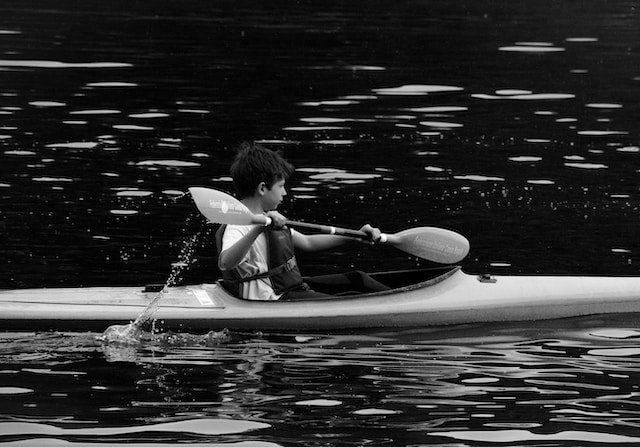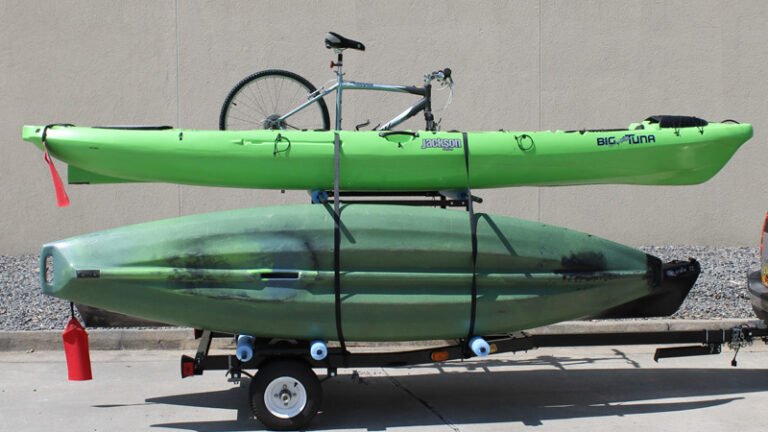How Old Do You Have To Be To Kayak?

Kayaking is a watersport that not only connects children with nature but also promotes physical fitness and instills a sense of adventure from a young age.
At What Age Can A Child Kayak?
Children aged 4 and older can learn to kayak. From ages 4 to 11, kids can comfortably paddle child-sized kayaks over short distances independently, provided they have the right equipment and appropriate water conditions.
NB: We strongly advise tandem kayaking with your kids before ever letting them try out their own child-sized kayak.
Benefits of Kayaking for Children
Development of Strength and Endurance
- Muscle Growth: Kayaking engages a variety of muscle groups, including the arms, shoulders, back, and core. As children paddle, they gradually build strength and endurance, which not only enhances their kayaking skills but also contributes to their overall physical fitness
- Cardiovascular Health: The rhythmic nature of kayaking provides an excellent cardiovascular workout. Regular kayaking sessions help improve heart and lung health, increasing a child’s stamina and energy levels.
Enhancing Self-Confidence and Self-Esteem
- Sense of Achievement: Mastering kayaking skills and conquering new challenges on the water instills a sense of accomplishment in children. This, in turn, boosts their self-confidence and self-esteem, fostering a positive self-image in the child.
- Setting Goals: Kayaking encourages goal setting. Children learn to set objectives for each trip, whether it’s reaching a specific destination or improving their paddling technique. Achieving these goals reinforces their belief in their abilities.
Improvement of Balance and Coordination
- Fine-tuning coordination: Balancing a kayak on water requires a delicate interplay of movements. Children naturally refine their balance and coordination skills as they learn to navigate their kayak through various water conditions.
- Motor Skills: Paddling techniques demand precise control over the kayak. This not only improves their gross motor skills but also fine-tunes their ability to react swiftly to changing situations.
Building Teamwork and Communication Skills
- Tandem Kayaking: Many children start kayaking in tandem kayaks. Tandems require cooperation and communication with a partner. This experience teaches them the value of teamwork and effective communication to navigate efficiently.
- Group Expeditions: Group kayaking trips with friends or family members encourage children to work together to reach common goals, strengthening their interpersonal skills.
Reducing Stress and Anxiety through Outdoor Activities
- Connection with Nature: Kayaking immerses children in the natural world, offering a break from the demands of modern life. Being surrounded by water, wildlife, and the gentle sounds of nature can have a calming and stress-reducing effect.
- Outdoor Adventure: Outdoor activities like kayaking provide an excellent outlet for pent-up energy and stress. Physical exertion and exposure to natural environments help reduce anxiety and promote mental well-being.
Encouraging a Sense of Community and Friendship
- Community Involvement: Kayaking clubs and communities provide a sense of belonging for children. They get the chance to connect with like-minded peers who share their passion for kayaking, fostering a sense of community.
- Lasting Friendships: The shared experiences and adventures of kayaking often lead to lasting friendships. Children form bonds with others who share their enthusiasm for this exciting water sport.
Safety Considerations for Child Kayakers
When it comes to kayaking, safety should always be the top priority for any age group or skill level. Ensuring that children have a safe experience on the water requires careful planning and adherence to essential safety guidelines.
Choosing the Right Kayak and Equipment
Sizing Considerations for Children
- Proper Fit: Selecting the right kayak for your child is crucial. Ensure that the kayak is appropriately sized for their age, weight, and height. A kayak that is too large can be challenging to control, while one that is too small may compromise stability.
- Adjustable Features: Look for kayaks with adjustable footrests, seats, and backrests. These features allow the kayak to grow with your child, ensuring a comfortable and secure fit as they develop.
Appropriate Life Jackets and Safety Gear
- US Coast Guard-Approved Life Jackets: Invest in high-quality, US Coast Guard-approved life jackets specifically designed for children. Ensure that the life jacket fits snugly and comfortably. Life jackets are a non-negotiable safety equipment for child kayakers.
- Additional Safety Gear: Depending on the kayaking environment, consider additional safety gear such as helmets for rough waters, waterproof communication devices, and a first-aid kit.
Supervision and Adult Presence
Adult Supervision
- Continuous Supervision: Children should never kayak alone, especially if they are inexperienced or young. An experienced adult should always accompany them on kayaking trips.
- Experienced Adult Guidance: The supervising adult should be experienced in kayaking and well-versed in safety protocols. Their expertise is invaluable in ensuring a safe experience for the child.
Set Boundaries and Safe Areas
- Establish Boundaries: Before kayaking, define clear boundaries and areas where the child is allowed to paddle. This helps prevent the child from venturing into dangerous waters.
- Awareness of The Surroundings: Teach children to be aware of their surroundings, including potential hazards such as rocks, fast currents, or submerged obstacles.
Weather and Water Conditions
Understanding Weather Patterns
- Check Weather Forecasts: Always check the weather forecast before heading out. Avoid kayaking in adverse weather conditions, such as storms, strong winds, or lightning. Remember, safety first.
- Local Area Knowledge: Acquaint yourself with local weather patterns, as they can vary significantly from one region to another. Sudden changes in weather can pose risks, so staying informed is crucial.
Avoiding Dangerous Water Conditions
- Water Level and Flow: Be aware of water levels and flow rates in rivers and lakes. High water levels or strong currents can make kayaking hazardous, especially for children.
- Tides and Waves: If kayaking in coastal areas, pay attention to tides and waves. Strong tidal currents and large waves can be dangerous.
Basic Kayaking Skills and Training
Enrolling Children in Kayaking Lessons
- Formal Training: Consider enrolling your child in formal kayaking lessons. These classes provide valuable instruction on kayaking techniques, safety procedures, and rescue skills.
- Qualified Instructors: Ensure that the kayaking instructor is experienced in working with children and emphasizes safety throughout the classes.
Practicing Essential Skills in a Controlled Environment
- Skill Building: Allow your child to practice essential kayaking skills, such as paddling, steering, and self-rescue, in controlled environments like calm lakes or slow-moving rivers.
- Supervised Practice: Supervise their practice sessions to provide guidance and correct any mistakes they may make while honing their skills.
Understanding Development Stages In Children and How that applies to kayaking
When exploring kayaking for your child(ren), it’s essential to consider how a child’s physical and cognitive development impacts their readiness for this kind of activity.
Children undergo significant developmental milestones in their early years, and these milestones play a crucial role in determining their ability to safely and effectively participate in kayaking.
We’re going to look into an overview of the key developmental stages for your kids and delve into how your child’s age influences physical readiness and cognitive development in the context of kayaking.
Infancy (0-2 years)
During this stage, children are in the early phases of physical development. They are learning to control their muscles and develop basic motor skills. Infants have limited physical strength and coordination, making them unable to actively participate in kayaking.
Early Childhood (3-6 years)
At this stage, children make significant strides in physical development. They gain better control over their muscles and start refining basic motor skills. While they may show interest in water activities, their physical abilities are still limited for kayaking. Supervised play and practice in calm waters are more suitable.
Mid Childhood (7-11 years)
Middle childhood is marked by considerable improvement in strength, coordination, and balance. Children in this age group are generally more physically ready for kayaking adventures, but they still require close adult supervision and suitable equipment.
Adolescence (12+ years)
Adolescents have achieved significant physical development milestones. They possess the strength, coordination, and balance required for more advanced kayaking experiences. Older children and teenagers can safely participate in kayaking with proper training, equipment, and adult supervision as needed.
Impact of Age on Physical Readiness for Kayaking
- Muscle Development: Age significantly influences muscle development. Older children and adolescents have more developed muscles, which are essential for effective paddling and control of the kayak.
- Bone Growth and Density: Bone growth and density increase with age. Older children and teenagers have stronger bones, reducing the risk of injury in case of accidents or falls during kayaking.
- Balance and Coordination Improvements: Balance and coordination naturally improve with age, making older children better equipped to handle the challenges of kayaking, such as maintaining stability in the kayak and maneuvering through water obstacles.
Some Fun Kayaking Activities With Kids
- Treasure Hunts: Create a sense of adventure by organizing treasure hunts where children paddle to find hidden objects or landmarks.
- Race Against the Clock: Challenge older children to timed races or obstacle courses to keep them engaged and motivated to improve their paddling skills.
Kayaking is a watersport that offers children the opportunity to connect with nature, enhance their physical fitness, and cultivate a sense of adventure from a young age.
It is a suitable activity for children aged 4 and older, with kids between 4 and 11 capable of paddling child-sized kayaks independently, given the right equipment and suitable water conditions.
However, it is strongly recommended to engage in tandem kayaking with children before allowing them to venture out in their own child-sized kayak for safety and guidance.






